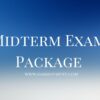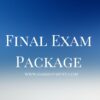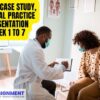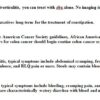Description
NR 511 Final Exam Part 4 (100/100 Points)
- In assessing an infant for developmental dysplasia of the hip (DDH), the practitioner places the infant supine, flexes the knees by holding the thumbs on the inner mid-thighs, with fingers outside on the hips touching the greater trochanters, stabilizes one hip, and abducts and gently pulls anteriorly on the other thigh. If this external rotation feels smooth with no sound present, there is no hip dislocation. This is:
- Bursitis is an inflammatory process that may be caused by infection, trauma, repetitive movement disorders, gout, or neoplastic disease. The most common cause of septic bursitis due to infection is from which of the following?
- Anne, age 67, sustained a fall on an outstretched hand. She presents holding her arm against her chest with her elbow flexed. Based on the specific location of her pain, you suspect a radial head fracture. The best initial strategy to assess for radial head fracture would be
- Hilda, age 73, presents with a complaint of low back pain. Red flags in her history of a minor fall, osteopenia, and prolonged steroid use for systemic lupus erythematosus suggest the possibility of which of the following serious underlying conditions as the cause of her low back pain?
- The nurse practitioner is considering a diagnosis of calcium pyrophosphate dihydrate (CPPD) crystal deposition disease or pseudo gout in a 72- year- old man who presents with complaints of pain and stiffness in his wrists and knees. The most useful diagnostic test to assist in confirming this diagnosis would be
- James, age 17, has been complaining of a painful knob below his right knee that has prevented him from actively participating in sports. He has recently been given a diagnosis of Osgood Schlatter disease and asks you about his treatment options. The nurse practitioner should tell him that the initial treatment is
- Which of the following is a modifiable risk factor for osteoporosis?
- What disorder affects older individuals, particularly women, and is characterized by pain and stiffness in the cervical spine and shoulder and hip girdles, along with signs of systemic infection such as malaise, weight loss, sweats, and low-grade fever?
- What is the name of the test used to assess for nerve-root compression?
- Which of the following is an X-linked recessive disorder commonly seen in African American males?
- Alexander, age 12, sprained his ankle playing ice hockey. He is confused as to whether to apply heat or cold. What should the nurse practitioner tell him?
- Sadie, age 40, has just been given a diagnosis of Graves’ disease. She has recently lost 25 lb, has palpitations, is very irritable, feels very warm, and has a noticeable bulge on her neck. The most likely cause of her increased thyroid function is
- To lower the serum concentration of thyroid hormones and reestablish a euthyroid state in the client with Graves’ disease, which of the following therapies may be used?
- The most common worldwide cause of hypothyroidism is
- An elderly client with hyperthyroidism may present with atypical symptoms. Which of the following manifestations are commonly seen in the elderly with hyperthyroidism?
- Which blood test should be obtained before initiating antithyroid drugs for Graves’ disease?
- Sandra, age 28, has secondary obesity. Which of the following may have caused this?
- Which is the only treatment option that is curative for primary hyperparathyroidism (PHPT)?
- Hyperthyroidism is seen in which of the following lab results?
- Which of the following can increase the ocular manifestations of Graves’ disease?
- Which of the following medications can increase uric acid and lead to an acute gouty attack?
- Reynolds is on the antithyroid drug methimazole (Tapazole), so you make it a point to check his
- Which of the following statements is true regarding the epidemiology of Graves’ disease?
- What is the medication of choice for an initial acute attack of gout?
- A client presents with clinical manifestations of hyperthyroidism. The differential diagnoses include Graves’ disease and subacute thyroiditis. Which of the following findings is consistent with subacute thyroiditis?
- Skip, age 4, is brought to the office by his mother. His symptoms are pallor, fatigue, bleeding, fever, bone pain, adenopathy, arthralgias, and hepatosplenomegaly. You refer him to a specialist. Which of the following tests do you expect the specialist to perform to confirm a diagnosis?
- After establishing clinical and biochemical euthyroidism after a thyroidectomy, you should perform a measurement of the serum thyroid stimulating hormone (TSH) level every
- The major risk factor for the development of thyroid cancer is
- Marsha, age 24, is preparing for radioactive iodine therapy for her Graves disease. Which test must she undergo first?
- The thyroid-stimulating hormone (TSH) test measures the
- Which of the following statements is true about the ophthalmopathy in Graves’ disease?
- Four clients present with an undetectable TSH level and a normal free T4 indicating subclinical hyperthyroidism. Which client should be treated?
- You suspect that Sharon has hypoparathyroidism because, in addition to her other signs and symptoms, she has
- Joy has gout. In teaching her about her disease, which food do you tell her is allowed on the diet?
- Why is parathyroid hormone secretion increased during pregnancy?
- Jimmy, age 6 months, is newly diagnosed with sickle cell disease. His mother brings him to the clinic for a well-baby visit. Which of the following should you do on this visit?
- Hemolytic anemia may be an inherited condition. Which of the following is not an inherited condition related to hemolytic anemia?
- Your client, Ms. Jones, has an elevated platelet count. You suspect
- Allie, age 5, is being treated with radiation for cancer. Her mother asks about the effect radiation will have on Allie’s future growth. Although she knows that a specialist will be handling Allie’s care, her mother asks for your opinion. How do you respond?
- Mandy, age 18, has infectious mononucleosis. What might you expect her blood work to reflect?
- Sickle cell anemia affects African Americans. Approximately 1 in 400 African Americans in the United States has sickle cell disease (SCD). Advances in treatment have been made, but life expectancy is still limited. The mean survival time for men with the disease is approximately
- Which of the following situations might precipitate a sickle cell crisis in an infant?
- Julie’s brother has chronic lymphatic leukemia. She overheard that he was in stage IV and asks what this means. According to the Rai classification system, stage IV is a stage
- Your client, Shirley, has an elevated mean cell volume (MCV). What should you be considering in terms of diagnosis?
- Sue has sickle cell anemia. In regulating her and monitoring her hemoglobin and hematocrit levels, you want to maintain them
- Macrocytic normochromic anemias are caused by
- You have a new client, Robert, age 67, who presents with generalized lymphadenopathy. You know that this is indicative of
- Bartley, age 58, presents with complaints of unsteady gait and numbness and tingling in her fingers. Her laboratory values show increased MCV, normal MCHC, and normal hemoglobin. Which of the following laboratory test results would you also expect?
- The gold standard for definitive diagnosis of sickle cell anemia is
- Mindy, age 6, recently was discharged from the hospital after a sickle cell crisis. You are teaching her parents to be alert to the manifestations of splenic sequestration and tell them to be alert to






